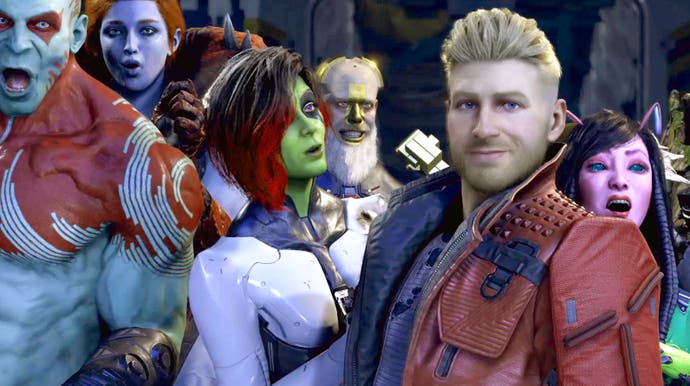Guardians of the Galaxy's RT upgrade adds extra shine to a brilliant game
An impressive addition for PS5 and Series X owners.
Guardians of the Galaxy surprised many this year - myself included - for capturing the essence of its characters - for taking the humour, the eclectic worlds and creatures of the comics, the films, and projecting it back out in video game form. Just ahead of Christmas, I'm glad to say developer Eidos Montreal has fine-tuned its work. Patch 1.05 adds new features alongside bug fixes, with ray tracing as the principal enhancement, substantially improving reflections over the standard quality mode. But what do these RT reflections actually deliver and is there any knock-on impact to the rest of the game? After all, hardware accelerated ray tracing is still a computationally expensive effect. Does something else have to give?
The ray tracing option on PS5 and Series X joins the two existing modes in the graphics menu. There's still the 4K resolution quality mode for visual purists, running at 30 frames per second. There's also the 1080p60 performance mode, which still has some trouble locking to 60 frames per second, as bizarre as that sounds. The new RT mode is what could be described as a replacement for the quality option: it's still pegged at 30fps and it still tops out at full 2160p, but the inclusion of RT sees the dynamic resolution scaling window expand - so you can expect to see 1620p resolution, for example, in rich battle scenes.
RT reflections essentially replace the screen-space alternatives seen in quality mode, meaning that all relevant details are reflected, not just those within the confines of the screen itself. It also sees all appropriate materials affected with reflections to a certain degree. These surfaces reflect and even distort nearby surroundings in a materially correct way. In some cases, the reflections are clearer to see while in others, they're more diffuse, depending on the surfaca. In fairness, the SSR technique in quality mode still holds up reasonably well and it's always been a respectable workaround. However, there are scenes where the impact of RT is simply transformative. Yes, resolution may be a touch lower, but it's difficult to tell in practice owing to the accumulation of detail over time added by temporal super-sampling anti-aliasing.
The majority of other visual presets appear unchanged from quality mode. Foliage quality draws in near identically, while level of detail transitions look like a match too. That said, ambient occlusion quality does take a hit, matching the lower quality preset used in the performance mode. Still, this is really the worst of the trade-offs to get ray tracing enabled on console and by and large, you're still looking at 30fps locked with only outlier dips.
Of course, Guardians of the Galaxy shipped with ray tracing at launch on PC, in addition to an excellent implementation of DLSS AI upscaling - so how do the consoles compare? PC features high, very high and ultra settings for RT reflections but there's also a transparency reflection toggle in addition to that, which sees reflections cast onto materials like glass. This isn't implemented on consoles, likely owing to performance implications. The standard RT settings see gradual improvements to ray tracing quality on other surfaces as you move up the presets. Consoles deliver the equivalent to PC's 'entry level' high setting, but the difference between the modes on offer is fairly limited, so that's absolutely fine.
Ray tracing, with all its benefits, is sadly missing on Series S. The new patch does add something in that you get the option for the unlocked frame-rate mode that we understand was actually in the gold master version of the game before being removed in the day one patch. To be clear, we had a 30fps cap before the this latest update with the game running at a native 1080p, but there was always the lingering sense that Series S could do more, especially in light of the Xbox One X's much higher pixel count. The new update simply offers the option to toggle between an unlocked frame-rate or the old 30fps cap.
The result in frame-rate testing is far from rock-solid but should be a good option for those with VRR-enabled displays. Series S uncapped does hit 60fps in less taxing scenes around the Milano and during interior missions, but in combat you're in a 40-60fps No Mans Land with occasional dips beneath that. On balance, it's a good option to have but I'm still left with the sense that Series S should be doing better. Ultimately though, the junior Xbox does offer a solid enough way to enjoy the game on consoles, but there's a wider than expected gulf between the S and X experience.
Looking at Guardians of the Galaxy as a patched package, the new ray tracing mode is a great extra. The only regret is that such a cool feature arrived after launch where early players - including our own John Linneman - had completed the game. The new mode is certainly worthwhile though and well optimised, but it's a shame that a locked 60fps mode remains elusive on any console. We hope to see Eidos Montreal return to the game one more time to deliver this crucial improvement to what is already a sensational game.



















